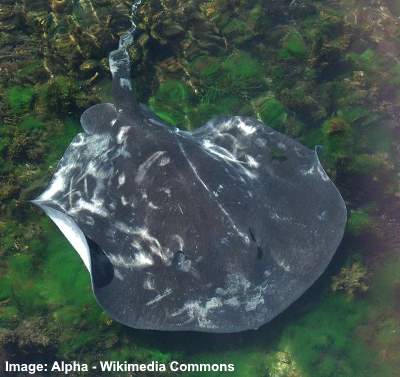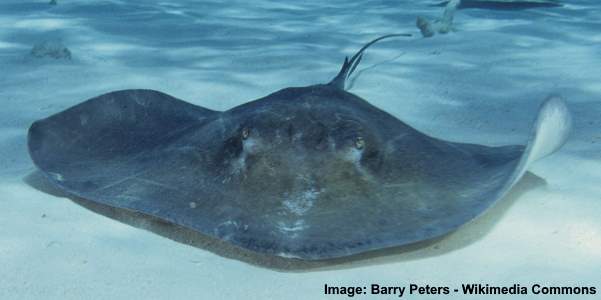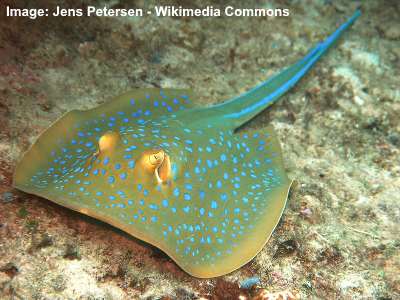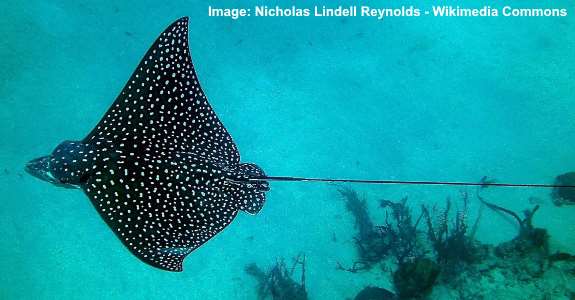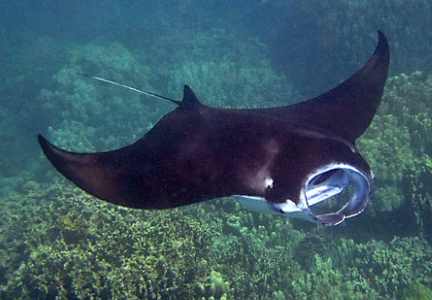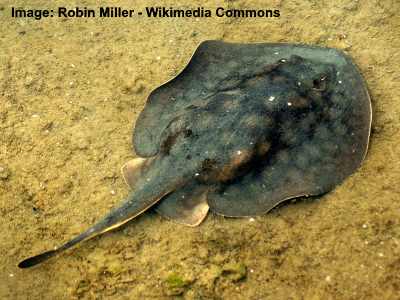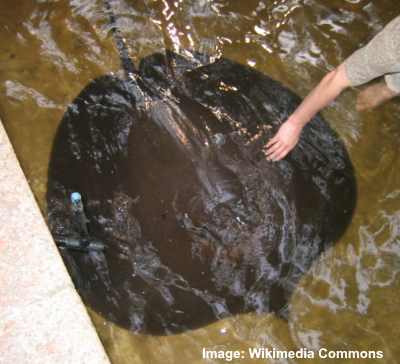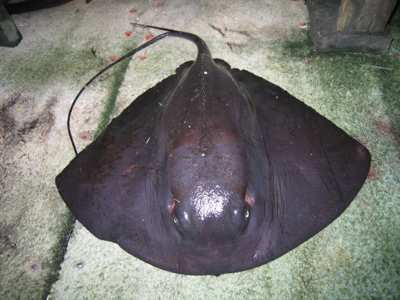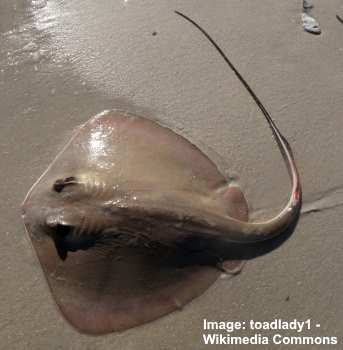Types of Stingrays: Varieties of Rays (Including Skate Facts) – With Pictures
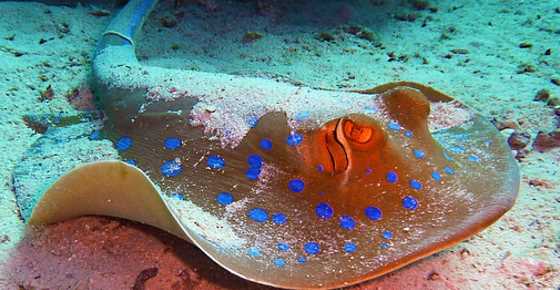
Stingrays are some of the most majestic and fascinating fish in the oceans and seas. With their broad pectoral fins, flat round shape, and long tails they seem to effortlessly glide through water. Most species of stingrays are found in tropical and subtropical marine environments. However, some types of sea rays live in colder waters, and there are also freshwater stingrays.
Stingrays are a type of fish belonging to the class Chondrichthyes and order Myliobatiformes. Stingrays are related to sharks and, just like their cousins, have a cartilaginous skeleton. All types of stingrays are classified into 8 families, and there are over 220 species of these rays.
The unusual shape of stingrays come from their broad pectoral fins that run the length of their body. To swim, some species of stingrays move their fins in a wavy motion. Other types of rays gracefully flap their wings similar to a bird.
Apart from their round or triangular shapes, an identifying feature of these fish is their long, pointed tails. Sea rays use these to ward off attackers. Some stingray species have venomous tails, and others have sharp tails with serrated edges. Apart from their roundish shape and distinct tail, most species of stingrays have mouths and gills on their underside. On the top of their bodies (dorsal side), they have eyes and openings (spiracles) that allow them to see and breathe.
In this article, you will find out about the most common types of stingrays. Along with their scientific names, pictures and descriptions of stingrays will help you identify the species.
Are Stingrays Dangerous?
Stingrays are not considered dangerous sea animals. They are generally docile creatures and are not known to attack humans. Even though there have been a few isolated incidents where some persons have died as a result of a sting, these are very rare.
According to an article in the New Zealand Medical Journal, stingrays “don’t attack humans if unprovoked.” Usually, any injuries from a stingray tail are due to accidentally stepping on a ray. The most common complications from a stingray sting are bacterial infections in the wound. (1)
Stingrays such as the southern stingray and yellow stingray are usually hard to spot against sandy bottoms. When swimming in areas where these tropical fish are present, you should be careful as to where you step. If you are stung, it’s important to get medical treatment to treat the sting properly and prevent secondary infections.
Skate Vs. Stingray
Stingrays and skates are from the same class of cartilaginous fish Chondrichthyes (which also includes sharks). However, skates belong to the family Rajidae. Although they may look similar, there are some differences between the skates and stingrays.
Generally, rays are much larger than skates. Another identification mark is that skates have a prominent dorsal fin near the end of their tails. Also, all species of skate are completely harmless as they don’t have venomous tails.
Another difference between stingrays and skates is that stingrays give live birth to their young, which are called pups, whereas skates lay eggs.
Types of Stingrays (With Pictures and Common Name)
Let’s look in more detail at some of the most common types of stingrays found around the coastlines of many countries.
Smooth Stingray / Short-Tail Stingray (Bathytoshia brevicaudata)
The smooth stingray inhabits warm waters around the coasts of Australia, New Zealand, and South Africa. As its common name implies, one of the identifying features of this ray is its short tail.
Looking at pictures of this stingray, you will notice that its triangular-shaped fins give the fish a diamond shape. Despite the short tail, this has rows of jagged thorns that can inflict a sting when provoked. As with most species of stingray, this one prefers to live on the sea bottom and is found in estuaries and reefs.
These majestic fish are one of the biggest types of stingrays. They can grow to over 7 ft. (2.1 m) across and weigh around 770 lb. (350 kg)! The color of its body is dark gray and may have white patches on it.
Southern Stingray (Hypanus americanus)
If you enjoy snorkeling in the Caribbean, Gulf of Mexico, Florida, or California, you are likely to spot a southern stingray. The danger of these stingrays is that they love to partially bury themselves in the sand. This makes it easy to step on them and they may sting.
These tropical rays have a distinct diamond-shaped body with a long stinging tail. The females can grow to 5 ft. (1.5 m) across and the male maybe only half that size. The dorsal side is usually olive-brown or green and they have a white underside.
Southern stingrays are docile and non-aggressive. Due to this, they are popular with tourists who enjoy diving and snorkeling with them.
Bluespotted Ray (Taeniura lymma)
The common name of this small sea ray comes from neon blue spots that cover its dorsal side. The 2 electric blue stripes running down its tail just add to the beauty of this stingray.
Bluespotted rays are a small type of stingray that only grow to 14” (35 cm) across. They have sandy yellow upper bodies that are decorated will luminous blue dots. Another way to identify this species of ray is by its large protruding eyes. You will also notice that they have thick tails that have also stingers.
Bluespotted stingrays are found in warm tropical waters in the Indian and Pacific Ocean. Their preferred habitat is coral reefs where they can hide during the day.
Eagle Ray (Myliobatidae)
Eagle rays are a large species of stingray with exceptionally long tails and triangularly shaped pectoral fins. These stunning rays usually swim in open seas and oceans and are rarely on the bottom. They can be found in the Atlantic Ocean and the Mediterranean Sea.
Eagle rays get their name from the way they seem to glide through the water like a flying eagle. They swim by flapping their large fins in a flying motion. Some species of eagle rays such as the common eagle ray can grow up to 8.5 ft. (2.6 m) across and have a total length of 6 ft. (1.8 m).
Although eagle rays enjoy swimming in the ocean, they also inhabit shallow sandy areas along coastlines. Sometimes their fins can be mistaken for shark fins then they break the surface of the water.
Spotted Eagle Ray (Aetobatus narinari)
One of the most stunning types of stingray is the spotted eagle ray. This species of eagle ray is found in warm tropical waters. Its triangular-shaped fins give the fish a rhomboidal shape.
The identifying feature of this stingray species is the number of white spots on its dorsal side. These contrast to the black or dark blue coloring of its body’s upper side. Another way to identify this ray is by its snout that looks like a duck’s bill.
These huge stingrays grow to around 10 ft. (3 m) across and have a combined length (body and tail) of 16 ft. (5 m). Other common names for the spotted eagle ray are bonnet skate, duckbill ray, and spotted duck-billed ray.
Common Stingray (Dasyatis pastinaca)
Native to the coasts of Europe and North Africa, the common stingray loves to spend its time on the sea bottom. They are usually found near the shore or up to a depth of 660 ft. (200 m).
The common stingray has a dark brown body and smooth skin. Its body shape is diamond-like and can measure up to 4.6 ft. (1.4 m) across. Together with its whip-like tail, this species of ray can measure 8.2 ft. (2.5 m) long. However, many species near the coast may be somewhat smaller.
This is also a stinging kind of stingray due to the venomous tail and serrated edges. Its sting can be painful, but not lethal.
Manta Rays (Manta)
Manta rays are a genus of eagle ray in the family Mobulidae. These are some of the largest types of rays you will ever see. These elegant marine animals have the characteristic triangular-shaped fins of eagle rays.
Some of the unique features to help identify mantas are the eyes and mouths. Unlike most stingrays, mantas have eyes on the side of their heads. Also, their mouths are forward-facing rather than downward. Depending on the type of manta, there may be stunning polka-dot patterns on their dark-colored dorsal side.
Some of the largest species of mantas can reach 23 ft. (7 m) across and weigh up to 2,980 lb. (1,350 kg). Despite their enormous size, these beautiful rays effortlessly glide through the sea.
Round Stingray (Urobatis halleri)
As its common name suggests, the round stingray has more of an oval disc-shape than angular diamond shape. This is a small stinging species of ray that is found in sandy coastlines of the eastern Pacific Ocean.
The brown color and lighter spotted patterns mean they blend in well with its surroundings. They often bury themselves in mud or sand and can be difficult to spot. Inadvertently standing on one often results in a nasty sting.
These small stingrays don’t usually have a disc width larger than 12” (30 cm) in females and 10” (25 cm) in males. Apart from its yellow-brown coloring and small size, you can also identify this stingray by its protruding eyes.
Giant Freshwater Stingray (Urogymnus polylepis)
As you can guess by its name, this is a large species of stingray that lives in rivers, estuaries, and other freshwater environments. The giant freshwater stingray is classed as one of the largest freshwater fish in the world.
This oval-shaped river stingray grows up to 6.2 ft. (1.9 m) across and can weigh as much as 1,300 lb. (600 kg). Its pectoral fins are relatively thin and this huge stingray has a gray-brown body. The freshwater ray is also identified by its long thin tail and elongated snout.
Giant freshwater stingrays are found in rivers in Thailand, Cambodia, Myanmar, and Malaysia. Its stinging tail won’t cause lasting damage, but it can cause a nasty sore sting.
Giant Oceanic Manta Ray (Mobula birostris)
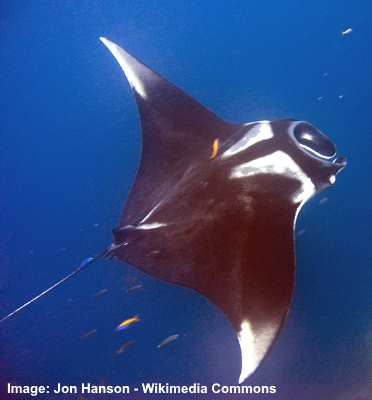
The giant oceanic manta ray is identified by the white markings behind its head and on the tips of its fins
Another of the ginormous types of stingrays is the giant oceanic manta ray. This is a ray that belongs to the eagle ray family and is found in tropical and temperate waters.
The interesting coloring on this dark-colored stingray is one of its unique identification marks. The triangular-shaped fins are black or steely blue and have brilliant-white tips. There are also white rectangular patters behind its head.
These massive stingrays have an average size of 15 ft. (4.5 m) across and some can grow up to 23 ft. (7 m). They are rarely seen near coastlines as they prefer swimming in the ocean. However, you may see juveniles near the coast where they spend a few years before heading out to sea.
Pelagic Stingray (Pteroplatytrygon violacea)
The unusual feature of the deep ocean pelagic stingray is that it is wider than it is long. Its fins have a wedge-shaped appearance and its body is dark purple to blueish-green.
Unlike the other stingrays on this list, the pelagic ray is one of the few that live exclusively in deep oceans. Their fan-shaped bodies are small and may only be 23” (60 cm) across. However, they have a long, thin whip tail that they use to defend themselves. This can be as long as 4.5 ft. (1.3 m).
Bull Ray (Aetomylaeus bovinus)
Another type of giant ray that lives in shallow waters is the bull ray. This large stingray gets its name from the bull-like shape of its head. In some countries, this fish has the name duckbill ray due to its round, flat snout.
Bull rays grow to an average of 8 ft. (2.5 m) across and have triangular-shaped pectoral fins that are curved backward at their tips. There are also striped markings running horizontally across its dorsal fins. As with most stingrays, it has a white underbelly.
Not much is known about the bull ray and it is classed as critically endangered.
Bluntnose Stingray (Dasyatis say)
The bluntnose stingray is a small type of ray fish that is found near the shores of the eastern coast of North America. This small stingray is dark brown in color which provides great camouflage on the sandy or muddy ocean bottom.
Bluntnose rays have a disc body in the shape of a diamond. As its common name suggests, it has a blunt nose and its body only measures 31” (78 cm) across. The stingray has a strong whip-tail that can be about 45” (1.5 m) long.
Because these are nocturnal fish, they are rarely seen during the day. Injuries from bluntnose stingrays are rarely life-threatening, but the pain from the sting can be excruciating.
Longnose Stingray (Dasyatis guttata)
Inhabiting coastlines of Central and South America, the longnose stingray is somewhat larger than its northern bluntnose cousin. This stingray species has an angular rather than oval shape and it has a long whip-like tail.
Longnose stingrays have diamond-shaped pectoral fins that are dark brown or olive-brown on the dorsal side. It gets its name “longnose” from the projecting snout that comes to a point. This gives the ray an appearance like a kite. An average adult ray will grow to about 4 ft. (1.25) across and has an extremely long thin tail.
The most danger this stingray poses is stinging people who mistakenly step on it or stinging fishermen who catch it in nets.
FAQ on Stingrays
Stingrays are unusual, yet fascinating fish. Here are the answers to a few questions you may have about stingrays.
Are stingrays in aquariums safe to pet?
Some aquariums have shallow petting pools that allow you to get up close to many species of fish, including stingrays. The stingrays in tanks and aquariums usually have their stinging spines removed from their tails so they aren’t dangerous.
How can I avoid getting stung by a stingray?
Because stingrays camouflage well, they are a risk for people swimming at the beach. The best way to avoid the nasty shock of getting stung is to drag your feet as you walk on the sand. This is called the “stingray shuffle.” This usually scares the stingrays and they will quickly swim away without harming you.
What should I do if a stingray stings me?
Although rarely life-threatening, getting stung by a stingray requires first-aid attention. You should rinse the affected area with plenty of water (freshwater or saltwater). If there is bleeding, apply pressure to control the bleeding.
To help relieve pain, place the affected area in hot water that is between 107°F and 113°F (42°C – 45°C). However, doctors advise that care has to be taken to avoid any skin burns. (2)
Related articles:


